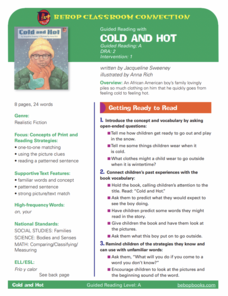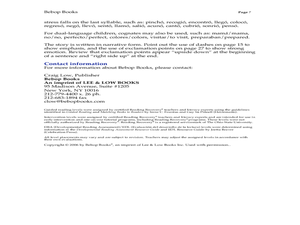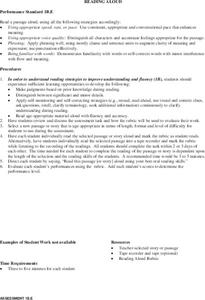EngageNY
Developing Reading Fluency: Criteria for Reading Aloud
Third graders develop their reading superpowers in a lesson plan on fluency. After first listening to an audio recording or teacher read aloud, the class works together identifying criteria for fluent reading, focusing on phrasing, rate,...
US Department of Education
A Close Reading of Lincoln’s Gettysburg Address
Abraham Lincoln's Gettysburg Address provides the text for a series of close reading exercises that model for instructors how carefully crafted guiding questions can help readers think critically about what they read, thus developing...
Florida Center for Reading Research
Fluency: Connected Text, Express It!
Partners practice reading fluency by reciting sentence strips to each other with proper expression and intonation. Partner A chooses a strip at random and reads it silently, then aloud with expression. Partner B reads the same sentence...
Florida Center for Reading Research
Fluency: Connected Text, Rereading Decodable Text
Using a familiar decodable text, pairs take turns reading sentences. The partner who isn't reading follows along silently, helping if needed. They alternate sentences until the entire book is finished and then reverse to read the other...
Wisconsin State Reading Association
Next Step in Guided Reading
Here are three guided reading lesson plan templates; each designed to meet the needs of a specific level of readers. Levels in focus are emergent, early, and transitional readers. Additionally, prompts to support your small group...
Curated OER
Reading Fluency
Aid readers in achieving fluency! Hone in on appropriate pacing, accurate pronunciation, and varied intonation through modeling and ample practice. In one-minute bursts, individuals rehearse reading a passage aloud, recording where they...
Curated OER
Guided Reading: Cold and Hot
Explore the text, Cold and Hot, with comprehension strategies for young readers. First, give them a purpose for reading: find out what the boy wore outside in the snow! Then have them use one-to-one matching and picture clues to...
Curated OER
Guided Reading with David's Drawings by Cathryn Falwell
First graders participate in a guided reading lesson. In this guided reading lesson, 1st graders read David's Drawings by Cathryn Falwell, which is a realistic fiction book on the DRA:16 level. They determine the author's message, and...
Curated OER
Reading For Information
To help learners better comprehend informational texts, they work through a series of activities. They discuss strategies, make predictions, skim passages, focus on key words, and practice taking notes. This lesson focuses on what to do...
Curated OER
Guided Reading with Elizabeti's Doll
Practice reading strategies using Elizabeti's Doll by Stephanie Stuve-Bodeen. Readers utilize decoding and comprehension strategies before, during, and after reading the story. A detailed list of text features, high frequency words,...
Florida Center for Reading Research
Fluency: Connected Text, Practice and Read
A reading activity boosts scholars' level of fluency while reading connected text. Working collaboratively, pairs read a word list three times and a specific text while their partner gauges their accuracy and speed.
Maryland Department of Education
The Concept of Diversity in World Literature Lesson 8: Nonfiction Close Reading
As part of their study of Things Fall Apart, class members conduct a close reading of a section of Chinua Achebe's essay, "An Image of Africa: Racism in Conrad's Heart of Darkness." Jigsaw groups then compare the voice in the essay...
EngageNY
Asking and Answering Questions: Reading about a Frog's Habitat
Building upon previous lessons, scholars take to asking and answering questions about a frog's habitat. A partner discussion follows a read-aloud of an informational text in preparation for a worksheet that boosts reading comprehension...
EngageNY
Reading about Freaky Frogs: “The Water-Holding Frog"
Boost reading comprehension skills with a lesson all about freaky frogs. A poem hooks scholars and takes them into a reading of an informational text followed by peer discussions. A three-page worksheet focuses on text features and...
EngageNY
Close Read, Part 1: “Taggot, the Blacksmith’s Daughter”
There would be no luck if it were not for bad luck. Scholars take a close look at the theme of adversity through multiple reads of Taggot, the Blacksmith’s Daughter. They place sticky notes on important details of the story and complete...
Scholastic
Folk and Fairy Tale Readers: The City Mouse and the Country Mouse
Support the growth of your emergent readers with this printable version of the classic fable "The City Mouse and the Country Mouse." Including supporting illustrations and simple dialogue, this story is perfect for developing the fluency...
Core Knowledge Foundation
Different Lands, Similar Stories Tell It Again!™ Read-Aloud Anthology
A read-aloud anthology highlights how one story differs depending on where it comes from. Scholars listen carefully to familiar and new stories, participate in discussions, and complete word work practice. Extensions for each lesson...
National Endowment for the Humanities
The Preamble to the Constitution: A Close Reading Lesson
"We the people of the United States, in order to form a more perfect union..." These familiar lines begin the Preamble to the Constitution, but do learners know what they mean? A close reading exercise takes a look at the language of the...
Curated OER
Reading Aloud
Reading aloud is a great way to engage learners in pacing and pronunciation! They practice using voice, pitch and intonation correctly. The teacher introduces the lesson plan by example, correctly stressing punctuation and using...
Curated OER
Building Fluency
As your youngsters begin to recognize the letters of the alphabet and their correponsding sounds, there are some they will be more familiar with than others. Cement their letter associations using this quick strategy, shown here with the...
Curated OER
Kites are Slow, Reading is Fast
Speed read with your third, fourth, and fifth graders. Learners pair up and work together to improve their oral fluency. Use the technique of covering up unknown words to isolate the vowel and decode the word. There's a sheet included to...
Curated OER
The Little Children That Can: Growing Independence and Fluency
Get ready to boost fluency in the classroom with this lesson geared toward elementary readers. Listening to the first half of The Little Engine That Could, learners focus on how voice changes create expression. They then read the rest...
Curated OER
Reading Connected Text Fluency (Passage)
Practice makes perfect when it comes to reading fluency! Walk your emerging readers through a familiar passage, slowly pointing to each word to keep every learner with you. While looking at a projected passage, scholars read one word at...
Curated OER
Guided Reading with Jazz Baby
Jazz music and musicians are the focus of this language arts lesson. Young readers independently read the book Jazz Baby. To build fluency and independence they read silently, but are guided by directive comments from the teacher. They...

























